Arc'teryx Thorium vs Cerium Jacket Comparison
Last Updated: January 01, 2025 | Author: Jake Thompson
In the grand tradition of outdoor enthusiasts arguing over gear as if the fate of their warmth depended on it, I find myself pondering the merits of the Thorium AR versus the Cerium LT.
As a seasoned writer in the realm of outdoor apparel, I've had the opportunity to experience both jackets in their natural habitat—the unforgiving wilderness. It's clear that Arcteryx didn't just throw a dart at a board when they designed these two contenders; there's a method to the madness, with each jacket offering its unique blend of insulation, durability, and style.
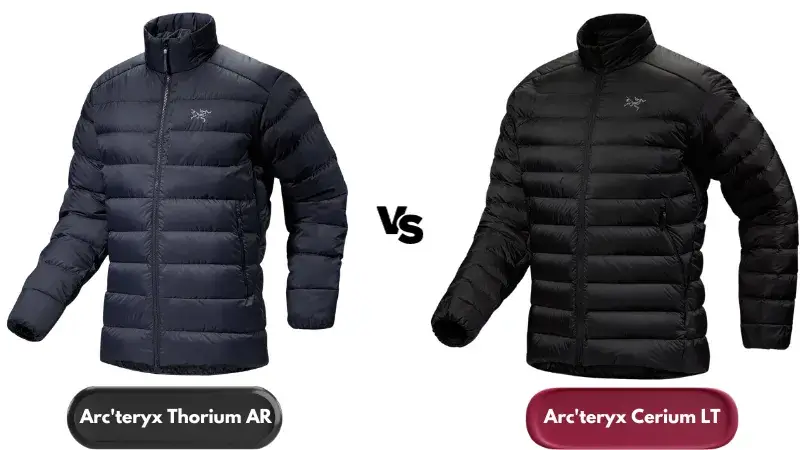
As we unpack the layers of these down-insulated rivals, you might just find that one of these jackets aligns perfectly with your outdoor ambitions—or perhaps the debate will inspire a closer look at what you truly require from your gear.
Delving into the technical aspects of outdoor jackets, our review of Atom LT vs Atom SL provides an in-depth look at the innovative technologies used in these jackets.
Table of Contents:
- Key Takeaways
- Table: Thorium vs Cerium Jacket
- Warmth
- Fill Material and Power
- Weight, Fit, and Features
- Hoodless Preference Limitations
- Alternative Insulation Recommendations
- Durability
- Comparative Weather Protection
- Frequently Asked Questions
Key Takeaways
- - Thorium AR is suitable for colder temperatures compared to Cerium LT.
- - Thorium AR provides better insulation in extreme cold conditions.
- - Cerium LT offers sufficient warmth for moderate cold temperatures to keep you warm.
- - Thorium AR has a higher fill power and more insulation, making the Thorium warmer than Cerium LT.
Table: Thorium vs Cerium Jacket
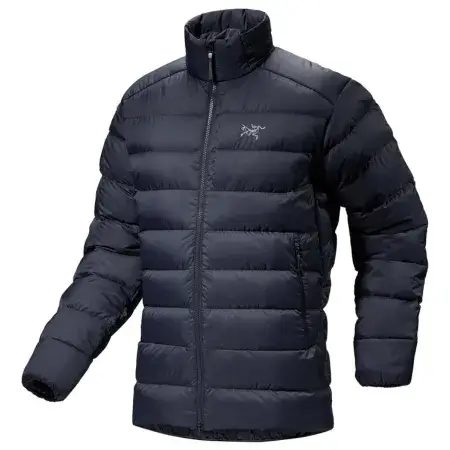 |
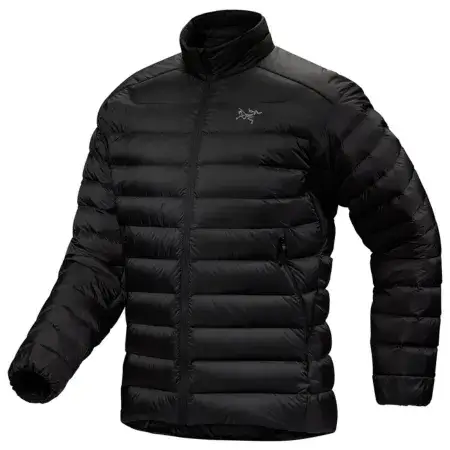 |
|
|---|---|---|
| Feature | Thorium AR | Cerium LT |
| Best Use | Multisport | Multisport |
| Fabric | Arato nylon | Arato nylon |
| Insulated | Yes | Yes |
| Insulation Type | Down | Down / Synthetic Blend |
| Insulation | 750-fill European white goose down/Coreloft synthetic | 850-fill-power European white goose down/Coreloft synthetic |
| Hood | Yes | No |
| Packable | Yes | Yes |
| Back Length | Hip-length | Hip-length |
| Back Length (in.) | 28.3 inches | 28.3 inches |
| Gender | Men's | Men's |
| Weight | 1 lb. 1.5 oz | 10.9 oz |
| Price |
Warmth
When evaluating the warmth of the Thorium AR and Cerium LT jackets, it's critical to note that the Thorium's higher fill weight and lower fill power provide superior insulation in more severe cold, whereas the Cerium's higher fill power offers a more efficient warmth-to-weight ratio for moderate conditions.
The Thorium AR hoody, insulated with a generous 750-fill European goose down, is adept at trapping heat, making it a go-to for those braving colder climates. Its strategically mapped Coreloft insulation in moisture-prone areas ensures warmth retention even when damp.
The Cerium LT, on the other hand, features 850 fill power goose down, which boasts loftier and more compressible insulation, translating to a lighter and more packable jacket that doesn't sacrifice warmth. This makes the Cerium LT an excellent choice for activities where weight and space are at a premium, yet where moderate insulation is still required.
It's essential to consider the integration of these materials; while both jackets employ down as the primary insulate, the Thorium AR's additional use of Coreloft synthetic insulation adds resilience against moisture compared to the Cerium LT's sole reliance on down. This hybrid approach enhances the Thorium's functionality across a wider range of conditions.
Fill Material and Power
Delving into the specifics of fill material and power, it's evident that the higher fill power of the Cerium LT's 850 down offers superior loft and insulation efficiency compared to the Thorium AR's 750 fill power down. The Cerium LT, insulated with filled European goose down, is the pinnacle of warmth retention per gram, enabling a lighter and more compressible garment. This higher fill power denotes a grander loft, which translates to a fluffier jacket with more air internal pockets to trap body heat. Consequently, it's the loftier option of the two, albeit with a lower gram weight of down.
Conversely, the Thorium AR, though it has a lower fill power, compensates with a heavier gram weight of downfill. The 750 European fill-down fortifies its capability to be one of the warmest options in its class. This fill material and power combination is adept at braving colder temperatures, providing a robust barrier against the chill.
In essence, while the Thorium AR is insulated with fill that's less efficient per gram, its increased quantity of down slightly tips the scales, making it super warm. The Cerium LT, with its higher fill, champions insulation efficiency, offering a remarkable warmth-to-weight ratio.
Weight, Fit, and Features
While the Cerium LT's superior loft and insulation efficiency set it apart, it's also essential to consider how the jacket's weight, fit, and additional features affect overall performance and comfort. The Cerium LT is remarkably lightweight, tipping the scales at a mere 10.9 oz, which translates to less fatigue and more agility on my hikes. Its packability is a standout, easily compressing into its stuff sack without a fuss.
The Thorium AR, though heavier, offers a reassuring robustness. The zipper is a two-way affair, granting easy access to harnesses and belay devices. Both jackets boast elasticized cuffs and a durable water-repellent finish, which fend off light precipitation and wind.
Diving into the details, here's a quick comparison:
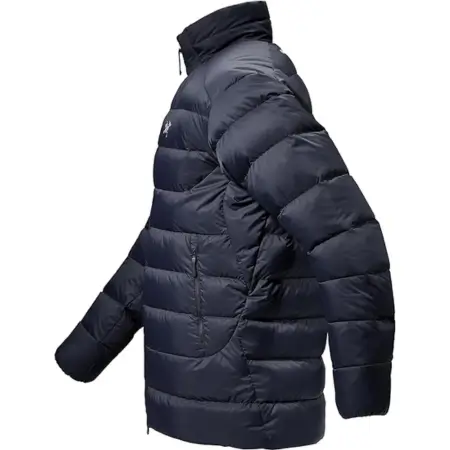
|
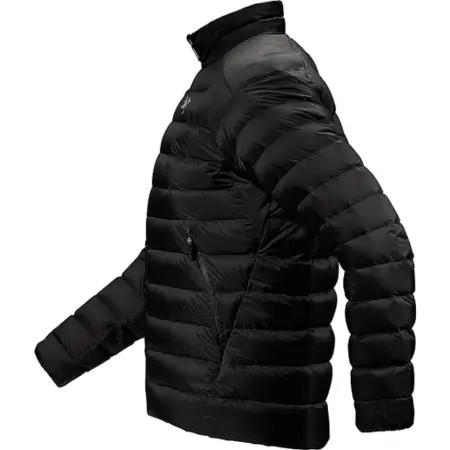
|
|
|---|---|---|
| Feature | Thorium AR | Cerium LT |
| Weight | 1.5 oz / 1 lb | 10.9 oz |
| Fit | Regular | Trim |
| Zipper | Two-way | Standard |
| Packability | Stuffs into sack | Highly compressible |
Choosing between them hinges on whether I prioritize durability and a relaxed fit, or if I'm seeking a minimalist, hoodless design that offers less bulk. Each has its merits, but the nuanced differences inform my decision.
Hoodless Preference Limitations
Despite their sleekness, hoodless jackets like the Thorium AR and Cerium LT come with inherent limitations, particularly in terms of versatility and protection in varying weather conditions. When breaking down these hoodless preference limitations, it's crucial to consider how these aspects may affect overall satisfaction with the jacket.
- - Hoodless Jackets Limitations:
- Versatility:
- Lack of a hood means less protection against sudden downpours or biting wind.
- You're more likely to need additional headgear, like a beanie or balaclava, which can be cumbersome.
- - Protection:
- Without a hood, the neck and chin area may feel exposed, despite a chin guard.
- A drop-tail hem can offer some additional coverage, but it's no substitute for hood protection.
Analyzing the Arcteryx Thorium vs Cerium, both jacket fits are designed with outdoor activities in mind, but the absence of a hood on certain models can present challenges. For instance, while hiking in unpredictable weather, a hooded jacket would provide quick and easy coverage. It's these nuances that one must weigh when considering a hoodless jacket.
The Thorium AR and Cerium LT, while top-tier in quality, aren't exempt from these considerations.
Alternative Insulation Recommendations
Considering the limitations of down insulation, particularly its reduced effectiveness when wet, it's worth exploring alternative materials like synthetic fill that maintain warmth even in damp conditions.
Synthetic insulation, such as PrimaLoft or Coreloft, is engineered to replicate the warmth-to-weight ratio of down while excelling in moisture resistance. Jackets insulated with these materials aren't only adept at retaining heat when wet but also dry more quickly than their down counterparts.
The durability of synthetic insulation is noteworthy. Unlike down, which can clump and lose loft over time, synthetic fibers are more resilient to repeated compression and tend to maintain their structural integrity. This results in a longer lifespan for the garment, especially in rugged conditions where the outer shell faces constant abrasion.
For those valuing weather resistance, synthetic-insulated jackets often come with robust outer shells that enhance protection against the elements. These shells are treated with water-resistant coatings and, when combined with synthetic fill, provide a formidable barrier against cold and wet climates.
In my experience, such combinations yield outerwear that stands up to a variety of conditions, making them a versatile choice for outdoor enthusiasts seeking reliable performance in unpredictable weather.
For a comprehensive understanding of performance jackets, especially in varying weather conditions, check out our comparison of Arcteryx Atom AR vs Atom LT.
Durability
When evaluating the durability of the Thorium AR and Cerium LT jackets, it's essential to consider the resilience of their materials and construction against wear and tear over time. Both jackets boast a durable fabric known as Arato, which is key to their longevity. However, there are noticeable differences:
- - Arcteryx Thorium AR
- Utilizes Arato 30, a denser and tougher weave
- More resistant to abrasions and punctures
- Enhanced durability aligns with its design for more rugged environments
- - Cerium LT
- Features a finer Arato 10 fabric
- Less robust compared to the Thorium AR
- Prioritizes weight savings over the ruggedness of the face fabric
The DWR (Durable Water Repellent) coating on both jackets helps them repel water effectively, but durability isn't just about withstanding moisture.
The tougher fabric of the Thorium AR means it's likely to outlast the Cerium LT in scenarios that involve rough contact, such as brushing against rock or carrying heavy backpacks.
In terms of technical wear, the careful consideration of fabric and construction is what sets these jackets apart in their capacity to endure the demands of outdoor adventures.
Comparative Weather Protection
While durability is a crucial factor in selecting an outdoor jacket, equally important is how well the Thorium AR and Cerium LT stand up to the elements, offering protection in diverse weather conditions. Both jackets have a durable water-repellent (DWR) coating, which allows water to bead up and roll off the fabric rather than soak in. This is vital in a sudden downpour or amidst snowfall, as it helps to keep the down insulation dry and effective.
However, it's worth noting that neither jacket incorporates gore-tex, which is often the gold standard for waterproof and breathable outerwear. Instead, they rely on their DWR coating and the inherent qualities of their respective shells.
The Thorium AR comes with a more durable Arato 30 shell, which offers a higher level of resistance to abrasion and tearing. This could be a deciding factor if you're trekking through rough terrain where branches or rocks might challenge the integrity of your jacket.
The Cerium LT, on the other hand, features a lighter Arato 10 shell, which is less robust but contributes to the jacket's lighter weight. It's a trade-off between durability and portability.
In heavy weather, you'd likely need an additional gore-tex hardshell to repel sustained rain or wet snow, since a DWR coating alone won't suffice in prolonged exposure. In my analysis, for those planning to encounter severe weather conditions, pairing either jacket with a robust shell would be the optimal approach.
For those interested in exploring similar high-quality outdoor jackets, our detailed comparison of the Patagonia Nano vs Down Sweater offers valuable insights.
Frequently Asked Questions
1. How Do the Maintenance and Care Differ Between the Thorium AR and Cerium LT Jacket to Maintain Their Insulation Properties Over Time?
I meticulously care for my down jacket by following washing instructions, using down-specific detergents, and drying it with tennis balls to maintain loft, ensuring it retains warmth and insulation properties over time.
2. Can Either the Thorium AR or Cerium LT Be Recommended for Use in Wet Conditions for Weather Resistance?
Neither's ideal for wet conditions due to the fill's poor performance when soaked. If drenched, I'd dry them flat, avoid direct heat, and fluff them up regularly to maintain loft during storage.
3. Are There Any Differences in the Warranty or Repair Services Offered by Arcteryx for the Thorium vs Cerium?
I'm not aware of any specific differences in warranty or repair services between the two. Arc'teryx generally offers comprehensive coverage, ensuring both jackets would be similarly protected against manufacturing defects or material failures.
4. How Do the Thorium AR and Cerium LT Jackets Perform in Terms of Breathability During High-Output Activities, and What Are Some Tips to Manage Perspiration While WeARing These Jackets?
I've found down jackets aren't the best for breathability in high-output activities. To manage sweat, I layer wisely and unzip for ventilation, ensuring I'm not overheating while on the move.
5. Can the Thorium AR or Cerium LT Be Integrated With Other Arcteryx Layering Systems?
I've found that integrating insulating layers with systems like the Arcteryx Proton or Atom lines enhances thermal efficiency and mobility, especially when conditions demand versatility and a broad temperature range.
6. How do Thorium and Cerium jackets compare in terms of packability, collar design, and suitability for skiing and snowboarding?
Thorium and Cerium jackets are almost identical in key areas such as being cozy, hip-length, and ideal for mid-layers in snowboarding or skiing. While both feature a shiny exterior and hand pockets, the Thorium jacket stands out with its casual quilt design, suitable for various occasions. In contrast, the Cerium jacket is known for its less bulky packability, making it efficient for outdoor adventures. The collar designs differ, with Thorium offering a laid-back style, and Cerium providing enhanced weather protection.
Share this:







